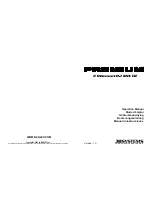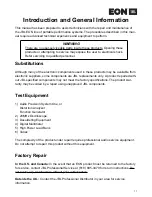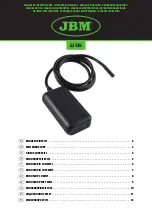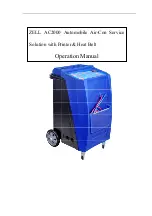
ETCO
2
The ResQCPR™ System includes the following two components:
1. ResQPUMP
®
ACD-CPR Device
2. ResQPOD
®
ITD 16
ResQCPR System Component:
ResQPUMP ACD-CPR Device
DEVICE DESCRIPTION
The ResQPUMP ACD-CPR Device (hereafter
referred to as ResQPUMP) (Figure 1) is a
multi-use, hand-held device that includes a
suction cup for attachment to the patient’s
chest (with clothing removed), and a handle
for the rescuer to hold onto.
The ResQPUMP
enables the rescuer to perform active compression-
decompression cardiopulmonary resuscitation (ACD-CPR)
, which differs from
standard CPR. During ACD-CPR, the chest is actively re-expanded (decompressed) after each
compression; with standard CPR, the chest re-expands passively. The ResQPUMP design allows
the operator to use the same body position and compression technique as in standard CPR.
Active chest decompression is achieved when the rescuer maintains a firm grip on the ResQPUMP,
bends at the waist and pulls his or her body weight upwards after compression. The suction cup
sticks to the chest and transfers the lifting force to the middle of the ribcage. Compression force
is transferred to the chest as in standard CPR via the device’s piston. The handle includes a force
gauge that displays the forces exerted during both chest compression and decompression (chest
wall recoil). The ResQPUMP has a battery-powered metronome integrated into the handle to guide
the rescuer in the appropriate compression/decompression rate. The metronome emits two-tone
signals of the same duration, one low and one high pitch tone. The signal (set at 80/minute)
guides the rescuer to compress and decompress at the appropriate rate and for equal amounts of
time (50% duty cycle).
If suction difficulties occur, adjust the angle of the ResQPUMP on the chest to obtain an adequate
seal. It may be necessary to shave hair from the middle of the chest to achieve good suction.
NOTE: If suction difficulties persist, the ResQPUMP can still be used for compressions without
causing additional harm to the patient, as long as it does not distract from CPR quality.
ResQCPR System Component: ResQPOD ITD 16
Instructions For Use
All users must read and fully understand these
ResQCPR System Instructions for Use (IFUs)
before using the ResQCPR System
or any of its components. The ResQCPR™
System includes the following components:
1. ResQPUMP
®
ACD-CPR Device
2. ResQPOD
®
ITD 16
USER INFORMATION: The use of other
medical equipment or drugs in conjunction
with cardiopulmonary resuscitation (CPR) may
impact the effect of compressions/decompres-
sions. Consult the instructions for use for other
equipment or drugs to assure that they are
used appropriately in conjunction with active
compression decompression CPR (ACD-CPR)
with an impedance threshold device (ITD) -
the ResQCPR System.
REQUIRED SKILLS: The ResQCPR System
should be used only by persons with
appropriate training, such as ambulance and
rescue personnel, or other medical staff who
have already completed a conventional CPR
course (e.g. American Heart Association,
American Red Cross, or equivalent), and who
have been trained on use of the ResQCPR
System.
RX ONLY
Federal Law (USA) restricts this
device system to sale by or on
the order of a licensed medical
practitioner.
CONTRAINDICATIONS
None known.
WARNINGS
Improper use of the ResQCPR System could cause serious injury to the patient and
ineffective chest compressions/decompressions. The ResQCPR System should only
be used by personnel who have been trained in its use.
Improper positioning of the ResQPUMP suction cup may result in possible
injury to the rib cage and/or internal organs, and may also result in suboptimal
circulation during ACD-CPR.
Do not use the ResQPUMP if the patient’s chest is not large enough for the ResQPUMP
suction cup to provide adequate compressions/decompressions during use.
Moisture, gels, or other lubricating materials on the patient’s chest should be removed
before applying the ResQPUMP. Failure to do so may result in sliding
of the suction cup on the chest, ineffective chest compressions/decompressions, and
possible injury to the rib cage or internal organs.
The ResQPUMP should not be used in patients who have had a recent
sternotomy. Use of the ResQPUMP in patients with a recent sternotomy
(within the past 6 months) has not been evaluated, but this may potentially cause
serious injury.
The safety and effectiveness of CPR using the ResQCPR System have not been
assured when used to treat cardiac arrest in patients with drug/medication
overdose etiology.
If the patient has a return of spontaneous circulation (ROSC) (e.g. palpable pulse)
during the resuscitation efforts, the ResQPOD should be immediately
removed from the airway circuit and use of the ResQPUMP should be
discontinued. Failure to do so may cause shortness of breath, difficulty breathing and
potential pulmonary edema if the patient begins to breathe spontaneously.
The ResQCPR System has not been studied in the setting of in-hospital cardiac arrest;
therefore, the safety and effectiveness of the device in this setting are unknown.
Clinical outcomes when using the ResQCPR System in the setting of an in-hospital
cardiac arrest. Therefore, the safety may be different from the outcomes observed in
the clinical trials of out-of-hospital cardiac arrest.
Safety and effectiveness of the ResQCPR System in pregnant women and
children under the age of 18 have not been studied in clinical trials.
Safety and effectiveness of the ResQCPR System in the setting of traumatic
injury (wounds resulting from sudden physical injury) have not been established.
PRECAUTIONS
Figure 1:
ResQPUMP ACD-CPR Device
Metronome
Force Gauge
Handle
Suction Cup
Figure 2:
ResQPOD ITD 16
On/Off Switch for
Timing Assist Lights
Inspiratory
Impedance
Regulator
Timing Assist Lights
Safety Check
Valve
INSPECTION PRIOR TO USE
Carefully inspect the ResQPOD in its package
before opening. Do not use if package is
opened or damaged, or if any defects are
noted.
HOW SUPPLIED
The ResQPOD ITD 16 is non-sterile and
intended for single patient use only. Dispose
of properly when use is completed.
DEVICE DESCRIPTION
The ResQPOD ITD 16 (hereafter referred to
as ResQPOD) (Figure 2) is a non-sterile, single
patient use, disposable impedance threshold device (ITD) that
limits passive air entry into
the lungs during the chest wall recoil (decompression) phase of CPR
, thereby
reducing intrathoracic pressure when rescuers are not providing a breath. Lowered intrathoracic
pressure results in greater venous return (preload) which, in turn, results in greater cardiac output
on the subsequent compression. It is inserted into the airway circuit between the patient and
the ventilation source, and can be used with either a facemask or advanced airway (e.g.
endotracheal [ET] tube). The ResQPOD may be used with standard ventilation sources (e.g.
bag-valve or demand-valve resuscitators, rescuer’s mouth, automated ventilator). It does not
restrict the patient’s ability to exhale, nor the rescuer’s ability to ventilate. The ResQPOD allows
the rescuer to provide periodic positive pressure ventilation while impeding passive inspiratory
gas exchange during the chest recoil phase. The ResQPOD ITD 16 includes a safety check
valve that allows inspiration at -16 cmH
2
O. The check valve is a design safety feature in the
event that the patient begins to breathe independently while the device is in place within the
airway circuit. Timing assist lights provide guidance to the rescuer on the proper ventilation rate
for a patient with an advanced airway.
PERFORMING CPR USING THE RESQCPR SYSTEM
Before beginning CPR with the ResQCPR System
(ACD-CPR with an ITD; Figure 3), always assess
the patient according to local standards to assure
there are no signs of circulation (e.g. consciousness,
breathing, coughing, movement or pulse). Begin
performing CPR with the ResQCPR System as soon
as possible but do not delay manual chest
compressions while preparing the ResQCPR devices.
PERFORMING CPR USING THE RESQCPR
SYSTEM IN ADULTS
1. Assure that patient is pulseless and that
resuscitation is indicated.
2. Place ResQPUMP; turn on metronome and begin
performing compressions to appropriate depth
(e.g. 2” or 5 cm) depth at rate of 80/min (see
additional detailed instructions on the use of the ResQPUMP below).
3. Attach ResQPOD to facemask as soon as chest compressions begin; use a
2-handed technique to maintain a tight facemask seal and airway position
(see additional detailed instructions on the use of the ResQPOD below).
4. After 30 compressions, pause and administer two ventilations over one
second duration each until the chest rises.
5. Continue to provide a 30:2 compression to ventilation ratio until pulse returns or
advanced airway is placed. Rotate ACD-CPR duties every two minutes to avoid fatigue.
6. Once an advanced airway (e.g. ET tube, supraglottic airway) is placed:
• Confirm tube placement and secure with commercial tube restraint.
• Move the ResQPOD to the airway and turn on the timing assist lights.
• Provide asynchronous ventilations; ventilate once (over one second until chest
rises) each time light flashes (10/min).
• Perform continuous chest compressions at 80/min. Do not pause compressions
for ventilations.
• Rotate ACD-CPR duties every two minutes to avoid fatigue.
7. If the patient has a return of spontaneous circulation (ROSC) the ResQPOD should
be immediately removed from the airway circuit and use of the ResQPUMP should be
discontinued. If the patient re-arrests, resume use of the ResQCPR System immediately.
Figure 3:
Use of the ResQCPR System
NOTE:
Signs and symptoms of improved
cerebral blood flow (e.g. eye opening,
gagging, spontaneous breathing, limb or
body movement) have been reported in
patients without a spontaneous pulse but
who are undergoing resuscitation with the
ResQCPR System. If these are noted, check
quickly to see if a spontaneous pulse has
returned. If the patient remains in cardiac
arrest, continue resuscitation with the
ResQCPR System and contact your medical
control authority or local protocol for
guidance on managing these signs and
symptoms in an arrested patient. If a
spontaneous pulse has returned, discontinue
the ResQCPR System and support ventilations
as indicated.
THE RESQCPR TEAM
It is highly recommended that rescuers work
in teams of 3 - 4 people. This enables one
person to perform ACD-CPR, one person
to hold the facemask in place with the
ResQPOD attached, and a third person to
manage the defibrillator and observe the
patient for signs of ROSC. In this team
scenario, the person compressing the chest
can stop after 30 compressions to provide
two positive pressure breaths (<5 seconds),
before resuming chest compressions. With
more personnel, two rescuers can manage
the airway.
ENSURING HIGH QUALITY CPR WITH
THE RESQCPR SYSTEM
• Check the ResQPUMP’s force gauge at
regular intervals to ensure that the
appropriate forces needed to compress
and decompress are being delivered.
• Use the ResQPUMP’s metronome as a
guide for compressing and decompressing
at the rate of 80/min. NOTE: This rate is
slightly slower than the rate recommended
for standard CPR in order to allow sufficient
time for blood return to the chest, and to
reduce rescuer fatigue.
• Rotate ACD-CPR duties every two minutes
to avoid fatigue.
• Once the patient has an advanced airway
placed, use the ResQPOD’s timing assist
lights to guide the proper ventilation rate.
Ventilate over one second duration and do
not hyperventilate!
• Avoid unnecessary interruptions.
DETAILED INSTRUCTIONS RELATED TO THE USE OF THE RESQPUMP
Proper use of the ResQPUMP is shown in
Figures 4 through 9
.
RESQPUMP POSITIONING
The ResQPUMP’s compression point is the same as for standard
manual CPR (Figure 4). Position the suction cup in the middle of the
sternum between the nipples (mid-nipple line). Make sure that the
edge of the suction cup does not extend below the xiphoid process,
as this could result in inadequate suction and/or rib injury.
RESCUER POSITION
Kneel close to the patient’s side. For optimal position, shorter
rescuers may find it beneficial to be slightly elevated by kneeling on
padding. If the patient is in bed (with hard surface under torso), it
will be necessary to kneel next to the patient or stand on a platform
of sufficient height. Grasp the ResQPUMP’s handle with both hands,
placing the heels of the hands near the gauge with wrists slightly
bent (Figure 5).
COMPRESSIONS WITH THE RESQPUMP
Compress the chest to the recommended depth (e.g. 2” or 5 cm),
observe the force required to achieve that depth, and then use that
force target as a guide. The amount of force required will vary
according to how compliant the chest is. Compress with shoulders
directly over the sternum, with arms outstretched and elbows locked
(Figure 6). Use the large thigh muscles to compress, bending at the
waist. Compress at a rate of 80/min and use the metronome to
guide the compression rate. Start and stop the metronome by
pressing the red button on the force gauge (Figure 7). Compress the
chest on one tone and lift on the other tone.
Note: The compression rate using the ResQPUMP
(80 compressions per minute) is different than the
current AHA-recommended rate of 100-120
compressions per minute for standard CPR.
COMPRESSION FORCE
The red arrow tip indicates the force being applied (Figure 7).
The approximate amount of force required to compress the
chest two inches (5 cm) is as follows:
• 30 kg (
≈
65 lb) of force: soft/supple chest
• 30 - 40 kg (
≈
65 - 90 lb) of force: chest of medium/average
compliance (Figure 7)
• 50 kg (
≈
110 lb) of force: stiff/rigid chest
Once it has been determined how much force is required to
compress the chest to the appropriate depth, use that amount of
force as a guide for continued compressions.
DECOMPRESSIONS WITH THE RESQPUMP
To provide active decompression, use the large muscles in the thighs
to lift, bending at the waist (Figure 8).
DECOMPRESSION FORCE
Decompress (lift) the chest until the tip of the red arrow on the force
Figure 4
Figure 5
gauge registers -10 kg (
≈
–20 lb) of force (Figure 9). This amount of upward
force must be exerted to fully achieve the benefits of active decompression.
Closely monitor the force gauge and suction cup seal during use. If the suction
cup dislodges, reposition it with the next compression; then, on the next
decompression, lift until just before the suction cup releases but do not exceed
-10 kg (
≈
-20 lb) of lift. Use a 50% duty cycle, spending equal time compressing
and decompressing.
SUCTION CUP REMOVAL
Lift up an edge of the suction cup lip to release the vacuum under the cup.
This will free the cup from the patient’s chest.
Figure 6
Figure 7
Decompression
Compression
30
0
kg
40
15
10
50
80/min
LIFT
to 10 kgs
Use enough
force to
COMPRESS
to 2” (5 cm) depth
Figure 8
Figure 9
TROUBLESHOOTING
1. If suction difficulties occur, adjust the angle of the ResQPUMP on the chest to obtain an
adequate seal. It may be necessary to shave hair from the middle of the chest to achieve
good suction. NOTE: If suction difficulties persist, the ResQPUMP can still be used for
compressions (with the metronome disabled) without causing additional harm to the
patient, as long as it does not distract from CPR quality.
2. Rib fractures can occur with any method of CPR, even if performed correctly. If it appears
that rib fractures have occurred, check to make sure the suction cup is properly positioned
and that compression depth is appropriate. The occurrence of rib fractures is not sufficient
reason to discontinue ACD-CPR.
3. If there are questions about whether the ResQPUMP is functioning properly, consider
discontinuing its use and perform standard manual CPR instead.
DETAILED INSTRUCTIONS RELATED TO THE USE OF THE RESQPOD ON
A FACEMASK
1. It is important to insert the ResQPOD into the ventilation circuit as soon as
chest compressions begin. In most cases this will involve placement on a
facemask; however, never delay the initiation of chest compressions while
waiting to place the ResQPOD.
2. The ResQPOD may be used on patients with or without an oral or nasal
airway.
3. Attach the ResQPOD to the facemask. (Figure 10)
4.
Obtaining and maintaining a tight facemask seal throughout
both chest compressions and ventilations is critical.
To achieve
this, spread out the cushion of the mask. (Figure 11)
5. Use a two-handed technique to maintain proper airway positioning and
obtain a tight facemask seal. Place the facemask onto the patient,
covering the nose and mouth. Obtain a tight facemask seal by either:
A. Using the thumb and base of the palm (Figure 12); or
B. Forming a “C” with thumb and index finger.
6. Place the remaining fingers on the bony part of the lower jaw and lift the
lower jaw to the facemask. Do not push the facemask into the face to try
and obtain a seal.
7. Tilt the head back and continue to lift the lower jaw to the mask.
(Figure 13)
8. Attach the ventilation source to the top of the ResQPOD.
9. DO NOT turn on timing assist lights. If rescue personnel elect to
perform continuous chest compressions and ventilate asynchronously with a
facemask, then the lights may be turned on and the rescuer should provide
a positive pressure ventilation on the upstroke of ACD-CPR every time the
light flashes.
10. Administer ResQCPR using the proper compression to ventilation ratio
(e.g. 30:2) and the proper ventilation duration (e.g. one second).
11. If there is only one rescuer available to manage the airway, then the
rescuer who is performing chest compressions can reach over and
provide ventilations during the pause in chest compressions, while
the rescuer at the airway maintains a two-handed facemask seal.
(Figure 13)
12. The ResQPOD is disposable and intended for single patient use. Cross
contamination may occur if the device is used on multiple patients.
1. Insert the advanced airway and confirm tube placement. Secure the tube
with a commercial tube restraint device. The use of tape to secure the tube
is not recommended.
2. Attach the ResQPOD to the top of the airway and attach the ventilation
source to the top of the ResQPOD (Figure 14); avoid interrupting CPR to
do this.
3. Turn on the timing assist lights. To activate, slide the ON/OFF switch to
the ON position.
4. Perform ResQCPR with continuous chest compressions (no pauses for
ventilations). Ventilate asynchronously when the timing lights flash (10/min)
and over proper duration (e.g. one second) until the chest rises.
5. If an end-tidal carbon dioxide detector is used, place it in the airway circuit
between the ResQPOD and the ventilation source. (Figure 15)
6. If there is desire to administer medications via the advanced airway,
remove the ResQPOD and administer medications directly into the tube,
then re-connect ResQPOD and resume use.
ADDITIONAL INSTRUCTIONS:
1. If there is a return of spontaneous circulation (e.g. palpable pulse) and chest
compressions are no longer indicated, immediately remove the ResQPOD
from the airway circuit. Failure to do so may cause shortness of breath and
difficulty breathing. Support respirations as indicated.
2. Immediately replace the ResQPOD in the ventilation circuit if the patient
re-arrests and chest compressions are again indicated.
3. If vomit or secretions enter the ResQPOD, remove the ResQPOD from the
facemask or airway adjunct and use the ventilation source to clear the
material from the ResQPOD. Suction the patient as needed, then re-attach
the ResQPOD and resume use. Discontinue use of the
ResQPOD if it cannot be cleared or if positive pressure ventilation is
compromised in any way with the device in place.
Figure 10
Figure 11
Figure 12
Figure 13
DETAILED INSTRUCTIONS RELATED TO USING RESQPOD ON AN ADVANCED
AIRWAY (E.G. ET TUBE):
Figure 14
Figure 15
FOLLOWING EACH USE OF THE RESQCPR SYSTEM
The ResQPOD is intended for single patient use only and should be discarded after use. Failure to
do so may cause cross contamination between patients. The ResQPUMP should be cleaned and
disinfected after every use.
RESQPUMP CLEANING
To clean the handle, wipe with damp cloth and mild detergent. The suction cup may be replaced
with a new suction cup, or cleaned. To clean the suction cup, wash it with a mild detergent and
rinse with tap water.
Never immerse the handle in water or autoclave to clean. Doing so may cause
permanent damage.
RESQPUMP CHEMICAL DISINFECTION
The handle and suction cup may be chemically disinfected after washing. Wipe the cup and
handle with a bleach solution (5% chlorine, minimum) or Cavicide
®
(follow manufacturer
instructions for wetting times). Wipe the handle with a dampened cloth to remove chemical
residue. Do NOT immerse the handle. The cup may be rinsed with water. Wipe with a clean
dry cloth and allow to air dry.
Hazards during disinfection. Always wear protective clothing during disinfection
of the ResQPUMP. Follow the handling instructions from the manufacturer of
the disinfectant.
NOTE: The cleaning procedure is sufficient after ‘normal’ soiling. If there are bodily fluids on the
ResQPUMP or if an infectious patient has been treated, the ResQPUMP should also be disinfected
as described above and the suction cup should be discarded and replaced.
RESQPUMP FUNCTION TESTING
Before placing the ResQPUMP into service and following each use, the following functional tests
should be performed:
1. Inspect the handle and suction cup for visible damage. Do not use the ResQPUMP if there is
obvious damage to the suction cup or handle. NOTE: Replacement suction cups are available
from the manufacturer.
2. Compress the ResQPUMP against a smooth hard surface with approximately 50 kg of force,
using the force gauge on the ResQPUMP as a guide. Observe for an increasing gauge
reading.
3. Pull up on the handle with approximately 10 to 15 kg of force, using the decompression
force gauge as a guide. Observe for a decreasing gauge reading and check for proper
suction. The gauge should move smoothly within the compression and decompression ranges.
4. Ensure that the force gauge reads zero (Figure 16) when no force is applied. If it does NOT
read zero, see instructions for force gauge readjustment below.
5. Assess the metronome’s battery level by pressing on the metronome button for more
than three seconds. If the battery is okay, first, a long high-note beep will be heard,
followed by three short beeps. If one long low-note beep is heard, or if no beep is heard,
the device should be replaced as well.
INDICATIONS FOR USE
The ResQCPR System is intended for use as
a CPR adjunct to improve the likelihood of
survival in adult patients with non-traumatic
cardiac arrest.
1
2
3
4
5
6
7
8
9




















